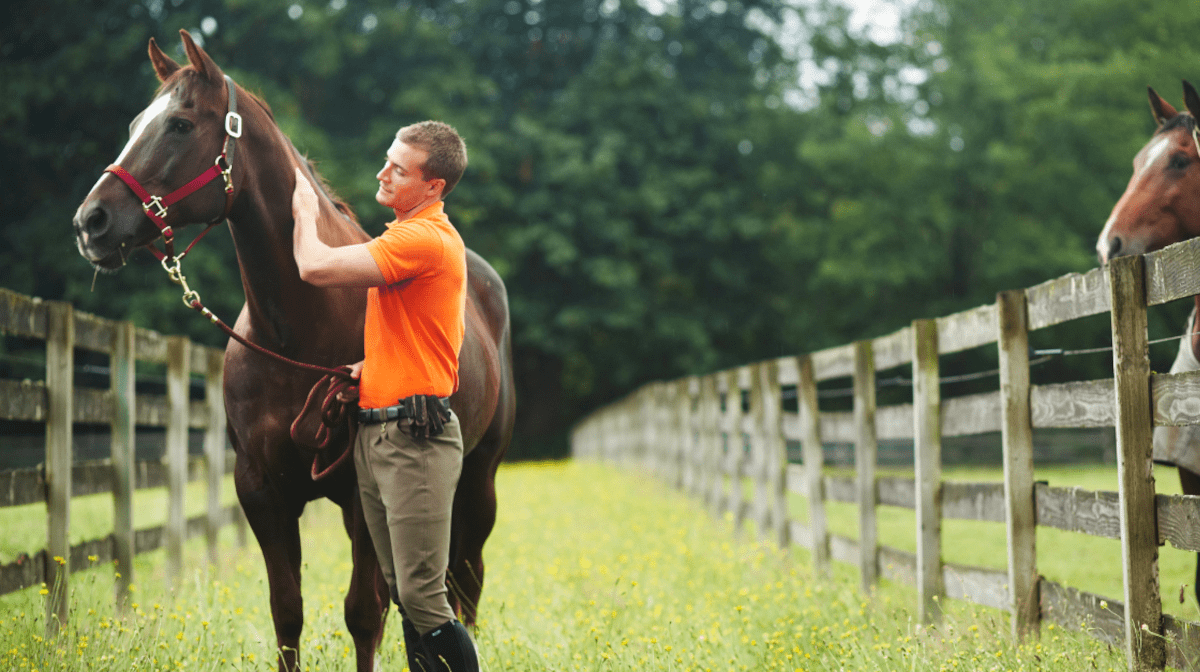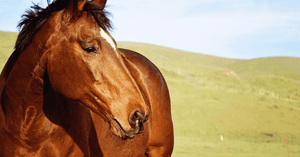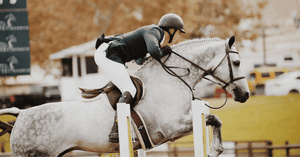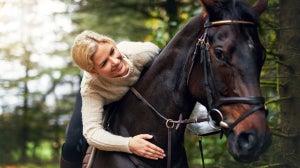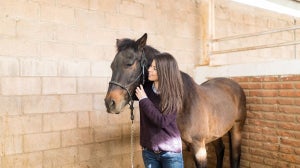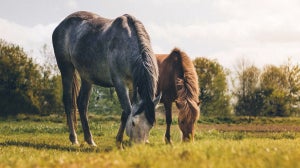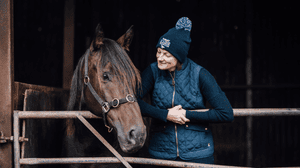
Just like humans, horses and ponies can suffer accidents, injuries, and health issues that require attention, whether these are immediate issues or ones to be managed in the long term. This is where a good understanding of equine first aid can be very helpful.
In this comprehensive guide, we’ll explore aspects of equine first aid that every horse owner or caretaker should know.
1. Being prepared2. Know your horse’s vital signs3. How to take your horse’s temperature4. How to check your horse’s heart rate5. How to check your horse’s breathing rate6. How to dress a wound7. How to deal with a foot injury8. Colic: An important concern9. Recognising and treating lameness10. Emergency situations11. Know when to call the vet12. Maintain regular veterinary visits13. Stay calm and stay safe1. Being prepared
The first step in equine first aid is being well-prepared. This involves having a well-stocked first-aid kit with items such as:
- Antiseptic solutions, wound dressings, cotton wool, vet wrap, bandages, poultice, wound cream or gel, bottle of sterile saline, disposable gloves, scissors, digital thermometer, head torch, duct tape and more.
It’s sensible to check your kit for expired items and replenish them when you need to.
2. Know your horse’s vital signs
Understanding your horse's normal vital signs is crucial for recognising when something is wrong. It’s advisable to monitor your horse's temperature, pulse rate, and breathing rate when you have any spare time while looking after them, to get used to what ‘normal’ is.
A horse's normal temperature ranges from 37.2°C to 38.3°C, while the resting heart rate is generally between 30 to 44 beats per minute, and the breathing rate is around 8 to 16 breaths per minute.
3. How to take your horse’s temperature
As mentioned above, knowing how to take the temperature of your horse is crucial in equine first aid. Follow these steps for an accurate reading:
- Gather supplies: You will need a thermometer, such as a digital rectal thermometer and some lubricant.
- Restrain and calm your horse: Choose a safe area where your horse can be restrained gently, as well as beings not too noisy as to spook your horse. Let them know you are there at the back end, by gently stroking their hindquarters.
- Position the thermometer: Stand just off to the side to be out of range of the horse’s hind legs (and wear a hard hat just in case). Lift the horse's tail gently and insert the lubricated end of the thermometer into the rectum. Be cautious and gentle to avoid causing discomfort. Angle the thermometer tip alongside the wall of the rectum (i.e. to avoid placing it into a ball of faeces), but be very soft and don’t ever force it.
- Wait for the reading: Keep the thermometer in place for about a minute so that you can wait for a consistent reading. The thermometer may or may not beep, depending on the model.
- Remove and read: Carefully remove the thermometer and read the temperature. A normal horse temperature falls within the range of 37.2°C to 38.3°C. If the temperature is outside this range, this is the time to consult your veterinarian and look into why the temperature might be too high or too low. Don’t forget to praise your horse if they have been well-behaved!
- Clean and store: Clean the thermometer thoroughly using disinfectant and then store it in a clean place for future use.
4. How to check your horse’s heart rate
Monitoring your horse's heart rate is another crucial skill for equine first aid. Here's how to do it effectively:
- Prepare: Find a quiet place again for your horse to stand.
- Locate the pulse: The most common location to check your horse's heart rate is the facial artery, located just under the jawbone. Gently press your fingers against this area until you feel the pulse. You may also be able to find a pulse at the back of the fetlock. If you are unsure of either position, ask your vet to show you at their next visit.
- Count the beats: Using a timer, count the number of beats you feel in 15 seconds. Multiply this number by 4 to get the heart rate per minute.
- Repeat and average: It's a good idea to take the heart rate a few times and average the readings for a more accurate result, as is helpful to do with humans!
- Compare to the normal range: A resting heart rate for a healthy horse usually falls between 30 to 44 beats per minute. If the heart rate is significantly higher or lower, consult your veterinarian again as to why this might be happening.
5. How to check a horse’s breathing rate
- Stand to the side of your horse and watch their flank rise and fall (or go in and out).
- One rise followed by one fall = one breath cycle.
- Count breaths for 15 seconds, and times by four to get their breathing rate per minute.
- Normal breathing rate is around 8-16 breaths per minute, and it is worth monitoring this in different scenarios.
6. How to dress a wound
Dressing a wound properly is another core skill in equine first aid that owners or caretakers would do well to learn. Following these steps can help you dress a wound if your horse is unfortunate enough to receive one:
- Prepare supplies: Ensure your hands are clean and wear gloves. Get your sterile gauze pads or dressings, non-stick bandages, adhesive tape, and an antiseptic solution.
- Clean the wound: Before dressing the wound, clean it gently with an antiseptic solution and water (made up in a clean bucket!). This is what helps to prevent any infection.
- Apply the antiseptic: If recommended by your veterinarian, apply an antiseptic cream or ointment to the wound.
- Cover with dressings: Place sterile dressings or gauze pads over the wound to absorb any fluids and protect it from any contamination.
- Secure with a bandage: Carefully wrap a bandage around the wound to hold the gauze in place. Make sure it's snug but not too tight, as proper circulation is crucial for the healing process.
- Use adhesive tape: With this you can secure the bandage in place, ensuring it doesn't shift or come off.
- Change dressing when you need to: Change the dressing as directed by your veterinarian. It’s always a good idea to monitor the wound, so keep an eye on it!
7. How to deal with a foot injury
Foot injuries for horses should be taken very seriously, as they can significantly impact not just their mobility but their overall wellbeing too. Follow these steps if your horse is ever unlucky enough to experience one:
- Assess the injury: Examine the affected foot carefully. Look for any signs of swelling, potential lameness, heat, or discharge. If you notice an object lodged in the foot, it’s likely that this needs to be examined and removed by a vet, as that could be very serious for your horse’s health. Do not attempt to remove it yourself – contact your veterinarian.
- Clean the area: If the injury isn’t serious or superficial, clean the area with a mild antiseptic solution and water.
- Allow your horse to rest: Resting or limiting their movement to prevent further injury is sensible. It will have been sore and so it’s best to allow them to recover and rest.
- Protect the foot: Depending on the severity of the injury, your vet might recommend wrapping the foot with a bandage to provide support and protection.
- Follow your vet’s advice: Always follow your veterinarian's guidance for treating foot injuries. Some injuries might require specialised care, so best to consult the professionals in these circumstances!
Remember - foot injuries can be complex and require veterinarian attention for proper diagnosis and treatment. Avoid attempting extensive treatments without professional guidance, as you could inadvertently worsen the injury.
8. Colic: An important concern
Colic, which refers to any abdominal pain, is a great concern in horses and must be treated seriously. Symptoms can range from being quiet and/or not wanting to eat to flank watching, pawing the ground, sweating, rolling and even recumbency.
If you suspect colic, contact your veterinarian immediately. Walking your horse can sometimes help alleviate symptoms in certain scenarios, but professional advice is always advised in the first instance.
9. Recognising and treating lameness
Lameness in horses can result from a range of issues, such as muscle strain, tendon or ligament injury, joint problems, or hoof issues. If you notice your horse is limping or moving differently, you should assess the affected leg for heat, swelling, or any objects that don’t belong. This is another core skill in knowing first aid for your horse.
Rest the horse and contact your veterinarian to determine the underlying cause and appropriate treatment.
10. Emergency situations
Certain situations will require immediate attention, such as a severe injury, laceration, colic or difficulty breathing. These situations may be scary or traumatic to experience, but the key is to remain calm, try to keep the horse calm and contact your vet.
If your horse experiences severe bleeding, apply pressure to the wound and contact your veterinarian. In cases of breathing difficulty, ensure proper airflow and seek help right away.
Always have the vet’s telephone number saved in your phone, and written down at the premises also.
Have clear guidelines on how to get to your horse’s location, whether a postcode or WhatThreeWords, to save valuable time. It can also be advisable to have an idea of transport for your horse at all hours so that it can be ready if and when required.
11. Know when to call the vet
While equine first aid knowledge is essential, there are times when professional veterinary care is crucial. If you're uncertain about the severity of an injury or illness, it's always better to consult your veterinarian.
Quick intervention from you can prevent complications and ensure your horse receives the care they need.
12. Maintain regular veterinary visits
Equine first aid is a valuable skill, but it's not a replacement for regular veterinary care. Schedule routine check-ups and vaccinations to keep your horse's health in good condition. A healthy horse is better suited to handle injuries and illnesses.
13. Stay calm and stay safe
In any emergency, it's important to stay calm and composed. Horses are intuitive creatures, and staying calm can help prevent further distress for the animal. Additionally, always prioritise your own safety. An injured or distressed horse can be unpredictable, so it’s advisable to be cautious when providing first aid for them.
To conclude, equine first aid is an essential skill for every horse owner or caretaker to possess. Being prepared, understanding your horse's normal vital signs, and knowing how to respond to various injuries and illnesses can make a significant difference to your horse's wellbeing.
Remember that while equine first aid knowledge is valuable, professional veterinary care is irreplaceable. By combining your efforts with the expertise of a professional vet, you can ensure the best possible care for your beloved horse.

